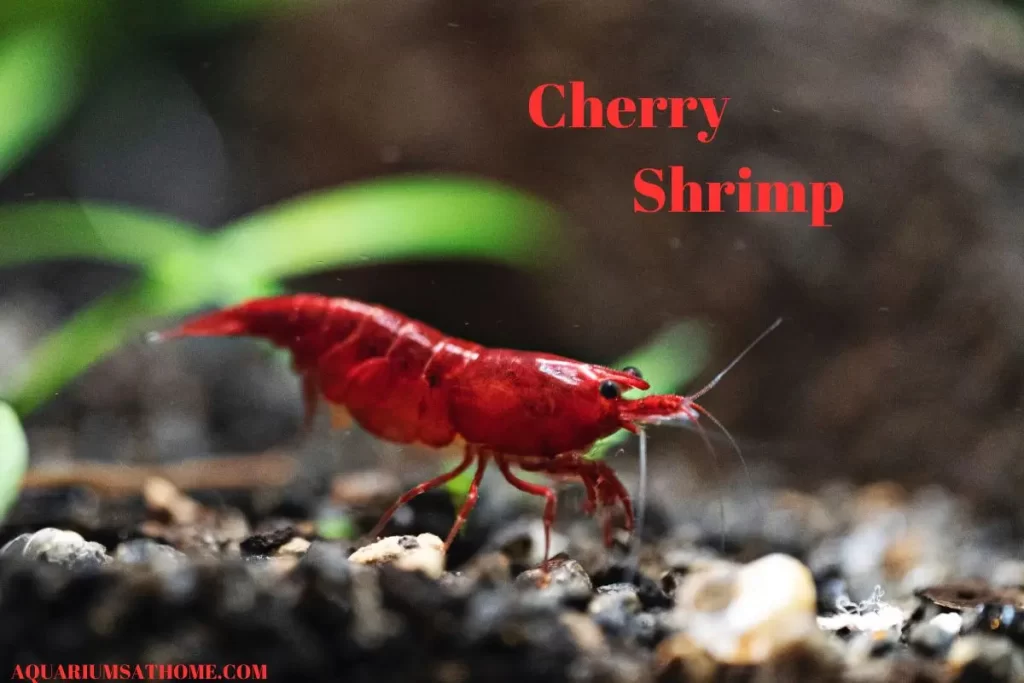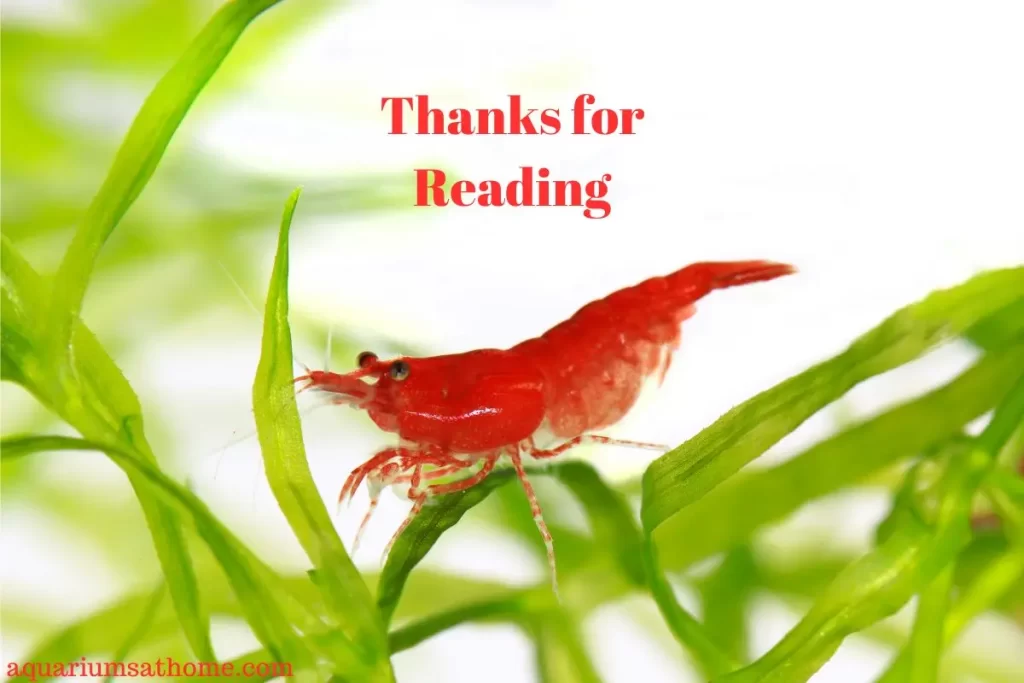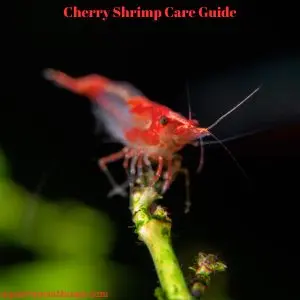Cherry shrimp, scientifically known as Neocaridina davidi, are vibrant and delightful creatures that have become increasingly popular in the aquarium hobby. Their striking red coloration and relatively easy-care requirements make them a favorite among both beginner and experienced aquarists.
In this comprehensive guide, we will explore everything you need to know to provide the ultimate care for your cherry shrimp. Let’s get started.
Natural Habitat
Cherry shrimp, scientifically known as Neocaridina davidi, are native to the freshwater rivers and streams of Taiwan. In their natural habitat, these shrimp thrive in densely vegetated areas with lush aquatic plants and abundant hiding spots, such as rocks, driftwood, and crevices. The water in their native environment is typically clean, with stable parameters conducive to their well-being.
Understanding the natural habitat of cherry shrimp is crucial for recreating suitable conditions in the aquarium. Aquarists should strive to replicate the dense vegetation and hiding spots found in their native rivers and streams.
Providing ample plants, such as mosses, java ferns, and aquatic grasses, not only enhances the aesthetic appeal of the tank but also offers essential hiding places for the shrimp.
Additionally, maintaining clean and stable water conditions is paramount. Cherry shrimp are sensitive to fluctuations in water parameters, including temperature, pH, and ammonia levels.
Regular water changes, proper filtration, and monitoring water quality parameters help ensure a healthy and thriving environment for the shrimp.
By recreating the natural habitat of cherry shrimp in the aquarium, aquarists can provide an enriching and fulfilling environment for these fascinating creatures to thrive and display their vibrant colors.

Appearance and Size
Cherry shrimp, scientifically known as Neocaridina davidi, are captivating invertebrates prized for their striking appearance. While their name suggests a vivid red coloration, cherry shrimp are available in a range of captivating hues, including vibrant yellows, blues, and even translucent varieties. This diversity of colors adds a delightful visual element to any aquarium setup.
In terms of size, cherry shrimp typically grow to measure between 1 to 1.5 inches (2.5 to 3.8 cm) in length, making them well-suited for smaller tanks and nano aquariums. Their petite stature allows them to thrive in compact environments without overwhelming other tank inhabitants.
Additionally, their modest size makes them an ideal choice for community aquariums, where they can peacefully coexist with a variety of fish and invertebrate species.
Behavior and Temperament
Cherry shrimp exhibit fascinating behaviors that endear them to aquarists of all experience levels. These small crustaceans are naturally curious and sociable creatures, often seen exploring every nook and cranny of the aquarium in search of food and shelter.
Despite their diminutive size, cherry shrimp possess an insatiable appetite for algae and detritus, making them valuable scavengers and efficient cleaners of the aquarium ecosystem.
Their docile and non-aggressive nature makes cherry shrimp highly compatible with a diverse array of tank mates. They coexist peacefully with many species of fish, including small tetras, rasboras, and guppies, as well as other dwarf shrimp varieties.
This makes them an excellent choice for community aquariums, where they contribute to the overall balance and harmony of the aquatic environment.
In summary, cherry shrimp are not only visually stunning but also exhibit captivating behaviors that add vibrancy and life to any aquarium. Their peaceful temperament and social nature make them a popular choice among aquarists seeking to create a harmonious and thriving aquatic community.
Fish Tank Size, Setup, and Water Parameters
Cherry shrimp are incredibly adaptable and can thrive in a variety of tank sizes, but a minimum tank size of 5 gallons (19 liters) is recommended to provide ample space and stability. When setting up the tank, it’s essential to create a natural and stimulating environment for the shrimp.
A well-established planted tank is ideal, as live plants not only enhance the aesthetics but also provide essential hiding spots and grazing surfaces for the shrimp. Mosses, java ferns, and anubias are popular choices that offer both shelter and sustenance.
In addition to plants, incorporating driftwood, rocks, and other decorations can further enrich the shrimp’s habitat and create diverse microhabitats within the tank. These features not only serve as hiding spots but also encourage the growth of beneficial biofilm, a natural food source for the shrimp.
Maintaining stable water parameters is crucial for the health and well-being of cherry shrimp. Keep the water temperature within a range of 65°F to 80°F (18°C to 26°C) to ensure optimal metabolic function and breeding conditions.
Aim for a pH level between 6.5 and 7.5 and moderate water hardness to mimic the conditions of their native habitat. Regular monitoring and adjustments, along with routine water changes, are essential for maintaining water quality and stability.
Diet
Cherry shrimp are omnivorous creatures with a diverse diet consisting of both plant matter and protein-rich foods. In the aquarium, they primarily feed on algae, biofilm, and decaying plant matter, which they graze on throughout the day. To supplement their diet and ensure optimal nutrition, it’s essential to provide a variety of foods.
Commercial shrimp pellets and algae wafers are readily accepted by cherry shrimp and serve as convenient staple foods. These pellets are formulated to meet their nutritional needs and can be offered in small quantities several times a week.
Blanched vegetables such as spinach, zucchini, and cucumber are excellent sources of fiber and essential nutrients for cherry shrimp. These vegetables should be boiled for a few minutes to soften them before being added to the tank.
For added variety and enrichment, occasional treats like bloodworms and brine shrimp can be offered as special treats. These protein-rich foods are eagerly consumed by cherry shrimp and provide a welcome change from their usual diet.
However, treats should be offered sparingly to prevent overfeeding and maintain a balanced diet for the shrimp. By providing a diverse and nutritious diet, aquarists can ensure the health, vitality, and vibrant coloration of their cherry shrimp.
Average Lifespan
Under optimal conditions, cherry shrimp can enjoy a relatively long lifespan, typically ranging from 1 to 2 years. However, with diligent care and a well-maintained aquarium environment, some individuals have been known to exceed this lifespan.
Factors such as stable water parameters, a balanced diet, and a stress-free environment contribute to the overall health and longevity of cherry shrimp.
By providing optimal conditions and attentive care, aquarists can maximize the lifespan of their cherished shrimp companions, ensuring years of enjoyment and fulfillment.
Tank Mates
Cherry shrimp are renowned for their peaceful nature, making them excellent tank mates for a wide variety of fish species. When selecting tank mates for cherry shrimp, it’s crucial to choose peaceful species that won’t pose a threat or compete with the shrimp for resources.
Small schooling fish such as tetras, rasboras, and guppies are popular choices, as they are unlikely to harass or prey on the shrimp. Additionally, other dwarf shrimp species, such as crystal red shrimp or amano shrimp, make suitable companions for cherry shrimp, fostering a harmonious and diverse aquatic community.
By carefully selecting compatible tank mates, aquarists can create a thriving and balanced ecosystem where cherry shrimp can flourish alongside their fish companions.

Breeding Cherry Shrimp
Breeding cherry shrimp is a rewarding and relatively straightforward process that can occur naturally within the confines of the aquarium. To encourage breeding behavior, it’s essential to provide ample hiding spots and vegetation for pregnant females to seek refuge and safely release their offspring.
Check out our Breeding Guide Here!
As the female cherry shrimp carries eggs beneath her abdomen, known as “berried,” she will eventually release the tiny shrimp fry into the water column. To ensure the successful development and survival of the young shrimp, it’s crucial to maintain pristine water conditions and provide an abundance of food sources.
By fostering a conducive environment for breeding and nurturing the offspring, aquarists can witness the fascinating life cycle of cherry shrimp firsthand, enriching their aquarium experience with the joy of new life and growth.
Common Diseases
Despite their hardy nature, cherry shrimp can still fall prey to various diseases, particularly when subjected to stressful conditions. Stress-related illnesses, such as bacterial infections and parasitic infestations, are among the most common health concerns for cherry shrimp.
Bacterial infections can manifest as symptoms like lethargy, loss of appetite, and discoloration of the exoskeleton. Parasitic infestations, on the other hand, may cause abnormal behavior, such as excessive scratching or rubbing against surfaces.
To safeguard the health of cherry shrimp, it’s essential to maintain excellent water quality and stability within the aquarium. Regular water changes, proper filtration, and the removal of uneaten food and debris help prevent the buildup of harmful bacteria and parasites.
Additionally, avoiding sudden fluctuations in temperature or water parameters is crucial, as these can stress the shrimp and compromise their immune systems. By providing a clean and stable environment, aquarists can minimize the risk of disease outbreaks and ensure the overall well-being of their cherry shrimp colony.
Cost
The cost of cherry shrimp can vary significantly depending on several factors, including coloration, size, and quality. Generally, these charming crustaceans are considered affordable and are readily available at most pet stores and online retailers specializing in aquarium livestock.
Prices typically range from just a few dollars per shrimp for standard color variations to higher prices for rare and sought-after color variants, such as Sakura, Fire Red, or Blue Dream.
Factors such as the shrimp’s size and breeding quality can also influence its cost, with larger, more vibrant specimens commanding higher prices. Additionally, the availability of certain color variations may fluctuate based on market demand and seasonal availability.
Despite these variations, cherry shrimp remain accessible to hobbyists of all budgets, making them an attractive option for aquarists looking to add color and vibrancy to their freshwater tanks without breaking the bank.
With their affordability and widespread availability, cherry shrimp continue to delight aquarists worldwide, offering endless possibilities for creative aquascaping and breeding projects.
Special Recommendations
Perform Regular Water Changes
Regular water changes are essential for maintaining optimal water quality in the aquarium. Aim to replace 10-20% of the water weekly to remove accumulated toxins, debris, and excess nutrients.
This helps prevent the buildup of harmful substances and ensures a healthy environment for cherry shrimp to thrive.
Avoid Copper-Based Medications
Copper-based medications or treatments should be avoided in shrimp tanks, as they can be highly toxic to these crustaceans. Even small traces of copper can prove fatal to shrimp and other invertebrates.
When treating illnesses or parasites in the aquarium, opt for shrimp-safe medications specifically formulated for invertebrates.
Quarantine New Additions
Before introducing new fish or plants into the main aquarium, it’s crucial to quarantine them separately to prevent the introduction of diseases or parasites. Quarantine tanks provide a safe environment for observing and treating new arrivals before they are deemed safe to join the main tank.
This practice helps protect the existing inhabitants and reduces the risk of disease outbreaks.
Provide Ample Hiding Spots
Creating a naturalistic environment with plenty of hiding spots and vegetation is essential for reducing stress and encouraging natural behavior in cherry shrimp. Incorporate driftwood, rocks, and live plants such as mosses and java ferns to provide shelter and grazing surfaces for the shrimp.
Hiding spots help shy or pregnant shrimp feel secure and minimize aggression from tank mates.
Final Thoughts
Cherry shrimp are indeed fascinating and rewarding creatures to keep in the aquarium. With their vibrant colors, peaceful nature, and relatively low-maintenance requirements, they make an excellent addition to any freshwater tank. Whether you’re a beginner or experienced aquarist, cherry shrimp offer endless opportunities for observation, breeding, and aqua-scaping.
By following the guidelines outlined in this care guide, you can ensure the health, happiness, and longevity of your cherry shrimp colony. From maintaining pristine water conditions to providing a varied and nutritious diet, every aspect of their care plays a crucial role in their overall well-being. With proper care and attention, you can enjoy the beauty and charm of cherry shrimp in your aquarium for years to come.
Common Queries
Can cherry shrimp live with fish?
Yes, cherry shrimp can coexist peacefully with many fish species, particularly small, non-aggressive ones. Choosing suitable tank mates is essential to ensure the well-being of both the shrimp and the fish.
Small schooling fish like tetras, rasboras, and endlers are excellent companions for cherry shrimp. Avoid aggressive or predatory fish species that may pose a threat to the shrimp.
By selecting compatible tank mates and providing adequate hiding spots, a harmonious community can be established where cherry shrimp thrive alongside their fish companions.
How often should I feed my cherry shrimp?
Feed your cherry shrimp small amounts of food 2-3 times a week, adjusting the frequency based on the amount of algae and biofilm present in the tank.
Cherry shrimp are omnivorous creatures that graze on algae, biofilm, and decaying plant matter throughout the day. In a well-established aquarium with ample natural food sources, such as algae-covered surfaces, feeding frequency can be reduced.
However, if algae is scarce or if the shrimp population is large, supplemental feeding may be necessary. Offer a variety of foods, including algae wafers, blanched vegetables, and specialized shrimp pellets, to ensure a balanced diet for your cherry shrimp.
Do cherry shrimp eat plants?
Cherry shrimp primarily feed on algae and decaying plant matter but may nibble on soft-leaved plants if hungry. While cherry shrimp are not considered destructive to live plants, they may occasionally graze on soft-leaved species like java ferns or anubias.
Providing a well-balanced diet and ensuring an abundance of natural food sources, such as algae and biofilm, can help deter cherry shrimp from nibbling on live plants. Additionally, selecting hardy plant species with tough leaves can minimize damage from shrimp grazing.
How can I encourage breeding in cherry shrimp?
Provide ample hiding spots and maintain stable water parameters to encourage successful breeding behavior. Cherry shrimp breed readily in the aquarium, given the right conditions.
Create an environment conducive to breeding by incorporating plenty of hiding spots, such as caves, crevices, and dense vegetation. Pregnant female shrimp seek out secluded areas to release their offspring, known as fry, into the water column.
Stable water parameters, including temperature, pH, and hardness, are crucial for successful breeding. Avoid sudden fluctuations in water quality, as these can stress the shrimp and disrupt the breeding process.
Are cherry shrimp sensitive to water parameters?
Yes, cherry shrimp are sensitive to changes in water quality, so it’s essential to maintain stable conditions to ensure their health and well-being. Cherry shrimp thrive in clean, well-oxygenated water with stable parameters.
Any fluctuations in temperature, pH, ammonia, nitrite, or nitrate levels can stress the shrimp and compromise their immune system, making them more susceptible to disease.
Regular water testing and maintenance, along with gradual changes during water changes, are essential for providing a stable environment for cherry shrimp.








